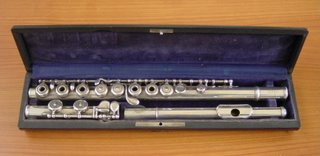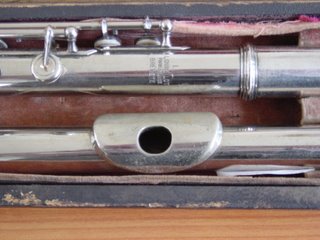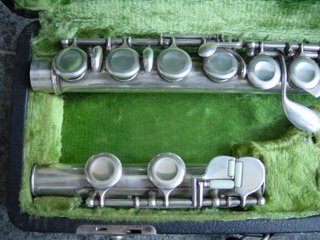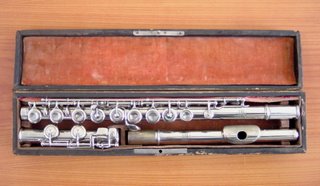Old and antique flutes
Call it crazyness but collectors are people of all times! Thanks to many of these persons we are able to discover the lines along which the developments of all kinds have come to these times!Information? Please mail me for contact: acakoevoets@kpnmail.nl
Thursday, August 10, 2006
Anonymous Instruments
ANONYMOUS INSTRUMENTS:
PICCOLO / BOXWOOD FLUTE
PICCOLO / BOXWOOD FLUTE
and early 20th century it was quite common for instrument
builders to supply instruments to dealers left unmarked.
The dealer was able to put his own name on the
instrument. Some details are very specific however
so within time we will find the actual manufacturer.
were at least at the joint reinforced with a metal tube.
Hence it wasn't that bad when a crack appeared in the wood
at some parts. The metal prevents it from leaking.
as at this moment too often happens in order to obtain
a louder tone e.g. the enlarging of the holes and
lipopening.
 The midsection of this instrument that is crackfree!
The midsection of this instrument that is crackfree! These older instrument may not be the loudest
These older instrument may not be the loudestbut their sound is so sweet that even piccolo haters
will love it!
BOXWOOD 5-KEYED FLUTE
This flute has been made out of boxwood en therefore
a very light instrument. Boxwood is quite precious and
harder to find but its resonance is incredible: A great
sounding instrument. As often happens this is a so
called stencil instrument made for one of the many dealers.
BONNEVILLE AUGUSTE
collection. As far as the sound goes these instruments are
hardly beatable!
this one must turn up to be a bit strange:
The addition of "Excelsior".
It's number places it between 1910 and 1920.
Sounding length proves to be about 602 mm.
No changes on the lipplate as well.
exquisite workmanship on this flute and
especially the crown.
Philipp Hammig Silver Flute
PHILIPP HAMMIG SILVER FLUTE (SOLD)
a very good player with two "faces":
By changing the heads you have quite another story to tell.
This instrument can be dated mid sixties and has the 900
silver hallmark on every part of the flute.
 Another picture of the Philipp Hammig.
Another picture of the Philipp Hammig.
Note the rollers fit onto the keys. Drawn toneholes.
Wednesday, August 09, 2006
William Haynes Flute
This flute from the thirties of the 20th century is
in a pristine condition. A beautiful player with that creamy
sought after tone good Haynes flutes are known for.
Besides al the inscription necessary you are able to
see the addition: "Special Model". We do not know
exactly what is so special on this silver flute but
we presume it to be the axes work mounted
directly on the tube itself. Nr. 12098 which place
it in the year 1932 produced on the 14th of May.
This flute can be found back in the registration
reports of W.Haynes described as CL G# C Spec.
CL G# stands for closed G#. The last prefix C
stands for C foot. William Haynes flutes from
before 1980 are considered to be from the golden
age of Haynes though they still are producing
fine instruments!
The unaltered lipopening.
The typical earlier Haynes keywork.
Everything in a "like new" condition.
Enough distance for this instrument to breathe!
And the pads are in great condition as well.
As has been stated earlier: solid silver.
A. Laurent Flute
A. Laurent Silverplated flute



The form of the keys and the ball shaped mechanism is allready
A nice crown which is quite significant for the Lebret heads

has been built by a lesser known person. Even the Langwill index
doesn't give any information about this flutebuilder.
However, the adress stamped onto the body is not far
situated from the Lebret workshops so chances are
big that it appears to be one of Lebret's foremen
who started his own business.
french cups. Besides that its'sound is very close to
the more renowned flutebuilders like Lebret and
others. I'm not acquainted with the fact that the
famous crystal flutes builder C. Laurent could
be an anchestor.
allmost unplayable condition it was clear to me that
it certainly had potentials. After a cleaning and repadding
job it appears to be absolutely true.
course the inline mechanism that is thought to have
a superior soundresult as the tube is able to vibrate
more freely.
Of course Leblanc is well known for his clarinets but his flutes
from the earlier years are a rewarding find as well.
This one is in need of a total overhaul but the notes
that do work sound really promising.
As can be seen on the lipplate this is a well used
flute from which one must conclude it is a good instrument.
The crown is worth a careful examination!
The engraving is done with care as well.
As far as I can see an unaltered lipplate.
A detail of the midsection showing its'mechanism.
Leblanc Flute
Of course Leblanc is well known for his clarinets but his flutes
from the earlier years are a rewarding find as well.
This one is in need of a total overhaul but the notes
that do work sound really promising.
As can be seen on the lipplate this is a well used
flute from which one must conclude it is a good instrument.
The crown is worth a careful examination!
The engraving is done with care as well.
As far as I can see an unaltered lipplate.
A detail of the midsection showing its'mechanism.
L.Lebret silverplated flutes

Somewhat curious is this example of a silverplated flute
by L.Lebret. Most of his flutes are open hole.
Besides that, this is a very early one, almost
one of the first 1000 instruments he built.
one of the first 1000 instruments he built.
As with most earlier instruments this one has a seamed tube.


there. L.Lebret started working on his own in 1888 after
spending a decade working in the Louis Lot workshop.
A nice crown which is quite significant for the Lebret heads
and the unaltered lipplate. This instrument has got the
qualities of a good french flute of that time.
The inscription ads: fournisseur des conservatoires.
Can be dated just before 1900.

This is a silverplated open hole L.Lebret flute.
In fact there are many of them but different in quality.
This one has that sought after creamy french tone
though it is a bit later example. In the thirties of
the past century Robert Malerne took over Lebrets'
workshop and produced flutes up until the mid fifties.
Louis Lot Silver Flute
LOUIS LOT SILVER FLUTE
At the time this instrument was produced Ernest Chambille
was the foreman of the company.
Made somewhere around 1921.
Some models only have a silver tube and plated keywork.
This one is a full silver example.
A nice detail of the crown of the head and the engraving.
The number of these flutes can be found on the head.
It has been overhauled completely by the old french flute
specialist Ton Kooiman (De Meern) and is a nice player.
Playing at A = 440 Hz this instrument has remained unaltered.
Louis Lot Chromeplated Flute
LOUIS LOT CHROMEPLATED FLUTE
made by Pauline Chambille who was the daughter of
Ernest Chambille. The number hasn't been stamped
on the regular place but somewhere hidden on the
post of the keywork.

The engraving somewhat differs from that of the early Louis Lots
instrument stamped on the post of the keywork
H.F. Meyer 11 keyed Flute
H.F. MEYER FLUTE
An original H.F. Meyer flute, one of Germany's finest flute builders
of the 19th century. The case is original and in a very good condition.
Even the spare pads are still there.
The typical endcap can be seen here together with the special
shape of the barrel. Other significant features are the angled
G# key and the mounting of the posts on plates.
The head was executed either in ivory or wood.
Most of the heads cracked however over time due to the metal
tube mounted inside. This embouchure has been pinned as well
but I'm not sure wether if this is a repair or actually done
by the fabrication of this instrument. It has been done with
care and is hardly visible. Probably done in order to keep
the wood around the mouthhole together.
A closer picture of the angled G# key and the posts of
it mounted on a plate that is screwed onto the body.
The rest of the eleven key lay out can be studied here.
The Dayton Miller collection holds some examples of
these flutes thought Wikipedia shows a picture of
a genuine H.F. Meyer as well.
The typical barrel form and the makers stamp
with the crown on top.
GEBRÜDER MÖNNIG FLUTE
The german flutebuilding (and other windinstruments) family
Mönnig gave birth to several remarkable instruments but besides
that also mediocre quality instruments during the DDR times.
This is a full Boehm flute that only has a metal head.
I still have to find out wether if it has been made out of silver.
Wooden flutes are rapidly increasing in popularity as
their sound is so beautifully rounded. This flute is no
exception: I expect it to be a professional flute made
just before Worldwar II. Great Player!
"OTTO MÖNNIG" PICCOLO
Beautiful ivoroid head and nickel plated keywork.
I think it to be a french instrument though a genuine
reform head made by Otto Mönnig came with it as an
extra but it did not fit onto this body.
reform head made by Otto Mönnig came with it as an
extra but it did not fit onto this body.

















































